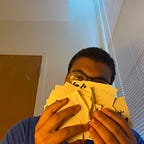“Ethiopian Knights:” A Jazz-Funk Prototype
I was a sophomore in my undergrad when I first stumbled across Donald Byrd’s Ethiopian Knights. I was familiar with some of his other work, more famously Places and Spaces, but Byrd’s music was uncharted territory for me. Upon first listen, I knew that this album was special, but I lacked the verbiage on why I liked it so much. So here I am a few years later with a couple of thoughts on the matter. Think of this article as less of an album review and more of an appreciation post for a project that I hold very dear to my heart.
Ethiopian Knights was recorded in 2 sessions in August of 1972 and was released in the subsequent year on the Blue Note label. Byrd was no stranger to the label, as this was his nineteenth record with them alone. Donald Byrd had previously made a name for himself as a hard-bop trumpeter and was slowly pivoting towards the jazz-funk sound, as many of his compatriots were. This pivot first showed up in Fancy Free (1969), his first album featuring an electric instrument. Byrd would slowly, but eventually fully immerse himself in the jazz-funk sounds as the years passed by. When I first stumbled upon Ethiopian Knights, I thought that this album would be his top selling. Surprisingly, that title belongs to Black Byrd (1973), quite literally his next release.
Now Ethiopian Knights is only three songs long with a total run time of over 36 minutes — that’s a lot of music crammed into 3 tracks. The bulk of the run time is in the first and last songs, “The Emperor” and “The Little Rasti.” The song in the middle, “Jamie,” is 3 and-a-half minutes long. Both “The Emperor” and “The Little Rasti” start off with a chorus-like introduction. However, the chorus is never played again in either song. I think this is so cool, it’s kind of like declaring to the world: “This is who we are, and this is what we do. Check this out!” The rest of the song is nothing but solos. “The Emperor” holds a bit closer to the traditional jazz feel while “The Little Rasti” isn’t afraid to get a bit looser. If I had to choose a favorite between the two, I would have to go with “The Little Rasti,” simply for it’s length.
The thing that I appreciate the most about Ethiopian Knights (and jazz-funk in general) is the rhythm section. In traditional jazz, the rhythm section is pretty consistent in their playing. They usually don’t deviate too far away from the general rhythm; all of the artistic stylings are reserved for the soloists. With Ethiopian Knights (and jazz-funk in general), the rhythm section gets in on the action, too. Wilton Felder, who would go on to Jackson 5 and Marvin Gaye fame, goes crazy on the bass in the background. You can hear him play the first half of a consistent bassline and play whatever he feels like on the second half. This goes for every instrumentalist in the rhythm section: the organ, the drums, the guitars, even the percussion get to express themselves in their own way. With everyone playing their own thing, you would think it would sound messy, but somehow it just works.
The synergy that the players share in albums like Ethiopian Knights is magical to experience. The length of each of the songs plus the ideas being shared in the music makes this feel less like a studio album and more like a jam session between friends (that just happened to be recorded with professional studio equipment). The only thing that snaps me back to reality that this is a studio album is the middle track “Jamie.” It has ballad-like feel to it and it serves as a transition between the two main tracks on the album. It’s apparent that this song has been rehearsed a few times, which is fine. I find myself only listening to it when I’m doing a full album listen.
Don’t get it twisted, there’s nothing new or technically impressive with Ethiopian Knights. It’s generally agreed that this isn’t his greatest work. But you know what? I don’t care. I think the reason why I like this album so much is that it encompasses everything that I like about jazz-funk in general. Each song is long, giving plenty of time for the players to get their ideas out. The rhythm section is extremely rich and has a lot of depth. I like listening to one instrumentalist in the background and seeing how they contribute to the greater overall sound. The players are all in a flow state and they sound good playing with each other. If the jazz-funk song I’m listening to meets the previous criteria, I think that I’m going to enjoy it. So thank you, Ethiopian Knights, for existing. You will always have a special place in my heart.
Thanks for reading!
